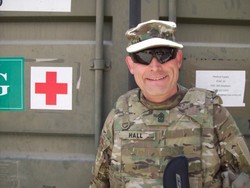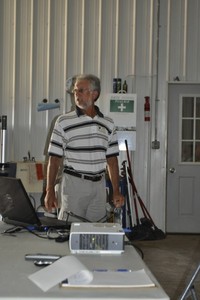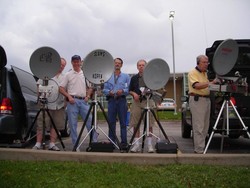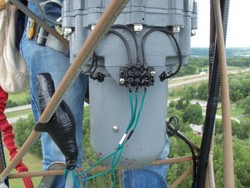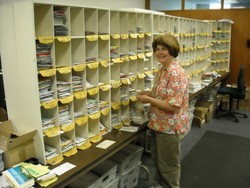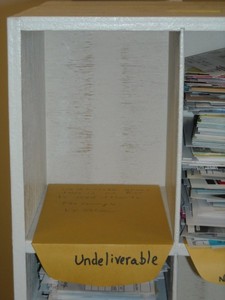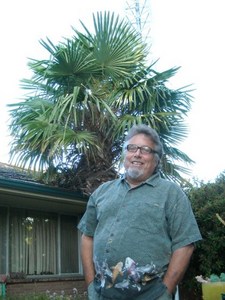 August 31, 2011 Editor: Ward Silver, NØAX | |||||||||||
IN THIS ISSUE
NEW HF OPERATORS - THINGS TO DO Why not give some of the short holiday CW sprints a try this weekend? The Adventure Radio Sprint has the "heavy-light" theme, the NS sprint begins with a slow-speed period, and there is the Labor Day Sprint, as well. The high-speed North American Sprint is on the following weekend - if you dare! BULLETINS There are no bulletins in this issue. BUSTED QSOS Your editor got a good log checking report last time! CONTEST SUMMARY Complete information for all contests follows the Conversation section Sep 3-4
Sep 10-11
The contest season begins anew - get rolling this coming Thursday evening with a joint PVRC/NCCC Webinar on the basics of Sprint contests with Hank Garretson W6SX. This presentation will be particularly helpful for newcomers to Sprinting. The webinar begins at 0100 UTC, Sep 2, and registration is free. The first webinar will conclude no later than 10 :00 PM EDT (0200 UTC) so that attendees can take a short break and roll right into the 30 minute NS (NCCC Sprint), which begins at 10:30 PM EDT (02:30 UTC). (Thanks, Ken K4ZW)
WRTC2014 is pleased to announce that it has received a Letter of Determination from the U.S. Internal Revenue Service granting 501(c)(3) status as a tax-exempt public charity. This means that contributions to WRTC2014, Inc. by U.S. taxpayers are deductible to the extent allowed by law. Contact info@wrtc2014.org or visit the web site for information on WRTC2014, and details on how to contribute. In addition, WRTC2014 has been recognized and endorsed by IARU at their recent meeting in South Africa! Eric K9GY/T6MO reports receiving word that Industrial Communications Engineers (ICE) Radio Products has been restructured and is once again producing the entire ICE product line. The name of the new company is Morgan Manufacturing Sales and the new website has just been launched.
Mike Wetzel W9RE is looking for the contact information for contest coordinators from the US and Canadian contest clubs. If your club has not been contacted, get in touch with Mike. The all-important Country (CTY) Files were updated on 27 August 2011. Used by your logging software to keep prefixes and DXCC entities and CQ zones straight, it's important to have the latest version. To install the file, follow the link to your software at the top of the page. (Thanks, Jim AD1C) Thanks to K6TD, the Cabrillo Statistics program originally developed by K5KA (SK) and now maintained by Bob N6TV, has just been ported to the Mac OS X environment. This program generates hour-by-hour rate sheets and valuable SO2R statistics from a Cabrillo-formatted file. It creates a simple text file that can easily be pasted into a reflector post. You may now download CBS version 10e for Windows, Mac OS X, and Linux. CBS Version 10e adds new support for NAQP-RTTY and CQ-WW-RTTY logs, as well as a number of bug fixes and minor improvements. This is a simple command line utility written entirely in C and is small enough to download from a slow dial-up connection (<100 kbytes). Please contact N6TV directly with a copy of your Cabrillo file if you run into any problems using the program. Jim K5ND notes that one good way to publicize ham radio is through Scouting's Jamboree on the Air held this year on October 15 and 16. It is the world's largest Scouting event with 2010 results coming in at over 700,000 participants from nearly 6,000 stations around the world. Please engage your local Boy Scout council to help them with a planned operation or to start one. This year JOTA stations have an opportunity to pre-register their events. Several are doing fox hunts as well. You can find lots of information online and on the ARRL site. This is a great way to not only reach the public but to expose youth to Amateur Radio. From AMSAT bulletin ANS-240, we learn that Kentucky Space, a consortium of Kentucky-based colleges and universities and Make Magazine announced the First annual hackerSPACE Workshop focused on CubeSat class satellites to take place in Lexington, Kentucky, November 11-12. If you do a lot of tower climbing or are otherwise interested in being trained in tower safety by professionals, check out this class. (Thanks, Bob N6TV) Dress for success takes on a whole new meaning when talking about wearable antennas as reported in Gizmag. Developed at Ohio State University, this is just the latest in "smart fabrics". There is even a bikini with integrated solar cells!
The Society of Midwest Contesters occasionally annual general meeting, known to some as the 5th ZO Fest, was held at the QTH of K9ZO in Bloomington, Illinois on Saturday, August 13. Many folks travelled over three hours just to be near the center of the Black Hole. It was satisfying to renew old friendships and welcome new folks. What a great way to have an annual meeting! Peter Dahl, KØBIT, legendary for his transformers that powered big signals around the world, died recently at the age of 71. He opened his own business in 1986, designing and manufacturing transformers for the military, TV and radio stations and hams. Many of those transformer designs are still available from Harbach Electronics. Web Site of the Week - On the Society of Midwest Contesters website you will find a link to their new club award/activity, the Grand Prix. The competition between club members encourages activity throughout the year. There are two VHF+ contests, three possible RTTY, two DX, domestic and two 160 meter contests. Up to nine contests can be counted for any one Grand Prix entrant. Maybe this could give your club some ideas to stimulate activity! WORD TO THE WISE Interlock - a software or hardware device that prevents transmitting more than one signal at any one time. This is an important new rule for multioperator stations in this year's CQ World-Wide contest. The old YSW method (Yelling, Swearing, and Waving) just doesn't cut it. Note that alternating CQs on two frequencies in the same band has been banned, as well. You know the old saw about towers and antennas, "If it stayed up last winter, it wasn't big enough!" Well, what if not only did it stay up but someone can parachute from the top of it...successfully? Radio Arcala just added another notch to their belts!
This hardware is even bigger! Space.com has published a photo album of 50 great photos of Russian rocket launches. Even after last week's failure of a supply vessel's third stage (the cause has been identified as described on the Space.com site) this is the route to space for American astronauts for the foreseeable future. You just might be a serious sci-fi hamster if you understand this photo. (Thanks, Joe KJ8O) The ARRL Rookie Roundup results for the first-ever RTTY version are now available. Joanna, K6YL repeated her April 2011 win as she led all challengers to the checkered flag with a score of 6437 points at the Stanford Radio Club station, W6YX, in the hills above Silicon Valley. (Thanks, ARRL Contest Branch Manager, Sean KX9X)
The 2011 Minnesota QSO Party Results are now available. (Thanks, Al KØAD) The Oceania DX Contest Committee is pleased to report that the results of the 2010 Oceania DX Contest are now available. A total of 1092 logs were processed with 21% more QSOs than last year, both of which are new records! As well as the more common VK, ZL, YB and KH6 stations there were a number of rarer Oceania entities active including V85, 9M6, AHØ, DU, and FO8. In particular, the 15 meter band really came to life. Plenty of records were also broken. This year's contest is only a few weeks away! (Thanks, Brian ZL1AZE) Russian DX Contest results for 2011 are now available, including SDR audio files in support of several disqualification decisions. (Thanks, Igor UA9CDC) The Arizona Outlaws Contest Club website features a neat "ladder" for the club's yearly competition for plaques. Click on "AOCC Ladder" on the left pane to see a spreadsheet with each Ladder Category. Click on the column's heading and after a second or two, you'll see the latest standings! Created by Dave AB7E and Sandy N7RQ, this might give other contest clubs some ideas about how to stimulate come healthy competition. (Thanks, Bob K8IA)
The IOTA Contest sponsors have received over 2,000 logs. Many also sent in photographs along with soapbox comments that appear on the website. You can see the list of activated logs and check that your entry is correct in terms of category, etc. The photo gallery has LOTS of great photos for your enjoyment. (Thanks, Don G3XTT) JARTS has announced the results of the 2010 WW RTTY contest the new rules for 2011. 925 logs were received for 2010. (Thanks, Hisami 7L4IOU) OPERATING TIP "The best way to communicate with someone is to use THEIR preferred method, not YOURS." - Mark N5OT. In a contest, that means you should be continually aware of the need to shift gears up or down when needed.
How can you measure the relative permeability of an unknown ferrite core? Place several turns on it and measure the inductance with a handheld LCR meter. Then use the formula AL (mH/1000 turns) = 1000000 x L / N2 with N being the number of turns. (For powdered iron cores, AL is in mH/100 turns.) This measurement only provides permeability information at the frequency of the measurement - typically quite low for LCR meters. A better method for HF and VHF testing would be to connect a capacitor across the toroid winding and use a dip meter to determine the resonant frequency. Calculate L from L = 25330 / f2 C, where f is in MHz, C is in pF, and L is in mH. Then calculate AL at the frequency of interest. The latest Fair-Rite Products catalog is an excellent source of material on ferrites. Another very good resource for identifying toroid cores (and many other useful functions) is DL5SWB's Mini Ring Core Calculator. This program has data on toroid cores from all identifiable makers, including dimensions and color coding which are usually the best parameters to check first. (Thanks, Carl KM1H, Jim K9YC, and Ian GM3SEK) Julius N2WN ran across this Epcos document that has a detailed explanation of gas-discharge tubes and how to choose them for lightning protection. The information is in German and English and is quite detailed.
Brian K1BRF relays the link to a Technology Review article that reports an improved Lithium-Sulfur (LI-S) battery chemistry that increases energy storage capacity by nearly an order of magnitude. That this would have far-reaching consequences is a bit of an understatement and certainly portable operating would benefit greatly. Gary K9AY provides advice for soldering radials: "For many years, dating from my first career in broadcasting, I have used silver-bearing plumbing solder commonly available in hardware stores and home centers. This is typically tin (Sn) with 0.25% or 0.5% silver (Ag). I tried the cheaper 100% tin, but the silver dramatically improves the solder flow and bond to the copper. Clean copper and the right flux is essential. Scotchbrite or similar pads are good; sandpaper may be needed to cut through deeper oxidation. The liquid acid flux works best, but is messy and corrosive -- wear gloves and wash things off when done. Paste flux works fine if the copper is clean, and is a lot easier to work with. I can't say enough about cleaning the copper -- everything is easier that way. A good physical connection helps too, since it will require less solder and flux. Finally, if you're concerned about protecting a soldered joint, a coating of black silicone or "liquid electrical tape" works well." The latest operating instructions for HFTA by author Dean N6BV, dated Aug 3, 2009, includes links for obtaining DEM, NED and SRTM geographical data and he confirms they all work. Dean's webinar "Hinks and Kinks for Using HFTA" and can be found in the PVRC webinar archive. Along with the observation about knowing when your antennas and towers are big enough, how can you tell that your slingshot is big enough? How about when it has a mount for a laser sight! Tom N4TL wrote in with news about the Big Shot® slingshot that looks like it would be a lot of fun in many, many ways! Dave N2NL/KH2L can probably relate as described in his recent blog entry about coconut trees. While EZNEC is the gold standard for ham antenna modeling under Windows, Linux users needn't despair. The xnec2c program also provides a lot of functionality as described in this video series by Steve AI4QR. (Thanks, Art AB4RL/6) A couple of issues ago, an item described methods for installing masts on tower. Eric K9ES contributes his method of using two thrust bearings, one on the top plate and one 5 feet below the top plate. You have to build the tower with mast already inside it at the bottom. When complete and guyed and with the rotator not yet installed, lift the mast inside the tower. Use a muffler clamp around mast to secure the rope from the gin pole. Attach the rope 60% of the way up the mast, above the center of gravity. When the mast extends a few feet beyond the top plate, lock the mast in place with thrust bearings. Install the top antennas on the mast and reposition the gin pole rope to the bottom of the mast. Continue to pull the mast through the thrust bearings after loosening the nuts, and tensioning the rope. Continue this procedure until the mast is high enough to allow the rotator to be installed, and lower the mast into the rotor clamps.
John KK9A contributes this handy formula for estimating tower work duration: Actual time = Estimate * Pi. Your editor can also speak from personal experience that this formula works for developing software, car repairs, the prep time for any recipe, weeding the garden, putting a child to sleep, and numerous other endeavors. It's difficult to identify SMD devices, but this on-line resource is quite complete, including links to data sheets for many of the items. English speakers will be able to skip over the Cyrillic text. If a pop-up claiming no data has been found - ignore it. (Thanks, Bob Dehoney) Technical Web Site of the Week - Tod KØTO built and measured 18 of high-impedance common-mode chokes with a complete write-up on his website ("Measurement of Chokes made using type 31 material cores" in the Experiments & Measurements section) showing how they were fabricated, how they were measured and the measurement results. He used Fair-Rite 2.4-inch diameter type 31 toroidal cores and small diameter, RG-59 size coax. The information should provide guidance to those fabricating their own common-mode chokes. Would You Know? Hurricane Irene just missed the US mainland but you might never know it from the damage totals and news videos. Even downgraded to a tropical storm by the time of landfall over Long Island, NY, there was still plenty of punch. Before the roads are even cleared, however, tropical storm Katia has formed and is expected to reach Category 3 status in a few days. It promises to be a stressful hurricane season for the Caribbean, the Gulf of Mexico, and the entire eastern seaboard. So why wait until the sound of plywood being nailed up is on the evening news? Would you know the frequencies of the Hurricane Watch Net and your state and local emergency nets? Do you know how to check in to such a net and submit or accept "traffic"? What would you do if you heard a distress call on the bands from a station in an affected area? If a person asked you to get a message into an affected area, how would you do it? That is not the time to start thinking about what to do! Competitive radiosport exists not because the FCC thinks we should have fun on the air but because our Basis and Purpose (Part 97.1) states that we are expected to provide emergency communications, among other things. By building competition-grade stations and training competition-grade operators, so the theory goes, Amateur Radio will be a resource to the nation in time of need. It doesn't matter much that you can "run rate", though, if you don't know how to use those skills.
Certainly, your local ARES team could use your skills. If you're not sure about the ham emergency organizations in your area, contact your ARRL Section Manager and ask for his or her help in finding the appropriate sources of information and groups. They'll be glad you called and you will, too. You can also prepare yourself by studying the material on the ARRL's Public Service website. Along with describing the operation of ARES and NTS, there are plenty of resources for you, too, all at no charge. You can also prepare by being informed about the areas likely to be affected. After all, a hurricane doesn't exactly sneak up on us - there is plenty of time for everyone to collect their wits and the necessary resources to be effective if called on. If a pinch of prevention is worth a pound of cure, then an evening of reading, printing, and study will certainly pay off, too. With the U.S. Labor Day holiday coming up, perhaps an hour or two could be set aside. You'll be better prepared all year long, too, so that your answer when needed is "Yes!" instead of "I don't know..." 31 Aug to 13 Sep 2011 An expanded, downloadable version of QST's Contest Corral in PDF format is available. Check the sponsor's Web site for information on operating time restrictions and other instructions. HF CONTESTS SNS and NS Weekly Sprints--CW, from Sep 2, 0200Z to Sep 2, 0300Z. Bands (MHz): 1.8-14. Every Thursday evening (local). Exchange: Serial, name, and S/P/C. Logs due: 2 days. Rules All-Asian DX Contest--Phone, from Sep 3, 0000Z to Sep 4, 2400Z. Bands (MHz): 3.5-28. Exchange: RS and age ("00" for YL). Logs due: Oct 31. Rules Russian Radio RTTY WW--Digital, from Sep 3, 0000Z to Sep 3, 2400Z. Bands (MHz): 3.5-28. Exchange: RST and oblast or WAZ zone. Logs due: Oct 1. Rules DARC 10-Meter Digital "Corona"--Digital, from Sep 3, 1100Z to Sep 3, 1700Z. Bands (MHz): 28. Exchange: RST and serial. Logs due: 2 weeks. Rules Colorado QSO Party--Phone,CW,Digital, from Sep 3, 1200Z to Sep 4, 0400Z. Bands (MHz): 1.8-28, 50+, Frequencies: CW--1.850, 3.550, 7.050, 14.050, 21.050, 28.050; Phone--1.870, 3.850, 7.250, 14.250, 21.350, 28.450. Exchange: Call sign, name, and county or S/P/C. Logs due: Oct 5. Rules IARU Region I Field Day--Phone, from Sep 3, 1300Z to Sep 4, 1300Z. Bands (MHz): 1.8-28. Exchange: RS and serial. Logs due: 16 days. Rules - see IARU Society Web pages AGCW Straight Key Party--CW, from Sep 3, 1300Z to Sep 3, 1600Z. Bands (MHz): 7. Exchange: RST, serial, category, name, age. Logs due: Sep 30. Rules QCWA Fall QSO Party--Phone,CW,Digital, from Sep 3, 1800Z to Sep 4, 1800Z. Bands (MHz): 1.8-28, 50+. Exchange: Call sign, year lic'd, name, chapter or S/P/C. Logs due: 30 days. Rules Tennessee QSO Party--Phone,CW,Digital, from Sep 4, 1800Z to Sep 5, 0300Z. Bands (MHz): 1.8-28, 50+, Frequencies: See website. Exchange: RS(T) and county or S/P/C. Logs due: Oct 6. Rules Labor Day Sprint--CW, from Sep 5, 2300Z to Sep 6, 0300Z. Bands (MHz): 1.8-28, 50. Exchange: RST, S/P/C, MI QRP nr or power. Logs due: Oct 7. Rules ARS Spartan Sprint--CW, from Sep 6, 0200Z to Sep 6, 0400Z. Bands (MHz): 3.5-28. Monthly on the first Monday evening local time. Exchange: RST, S/P/C, and power. Logs due: 2 days. Rules 070 Club KA3X Memorial Sprint--Digital, from Sep 9, 8 PM to Sep 10, 2 AM. Bands (MHz): 3.5. Frequencies: 3.580. Exchange: Call sign, RST and S/P/C. Logs due: Oct 9. Rules Worked All Europe DX Contest--Phone, from Sep 10, 0000Z to Sep 11, 2400Z. Bands (MHz): 3.5-28. Exchange: RS and serial. Logs due: Sep 28. Rules Arkansas QSO Party--Phone,CW,Digital, from Sep 10, 1500Z to Sep 11, 0300Z. Bands (MHz): 3.5-28, 144, Frequencies: CW--3.550, 7.050, 14.050, 21.050, 28.050; Phone--3.980, 7.260, 14.260, 21.360, 28.360, 145-147. Exchange: RS(T), county or S/P or "DX". Logs due: Nov 1. Rules Ohio State Parks On the Air--Phone,CW,Digital, from Sep 10, 1600Z to Sep 10, 2400Z. Bands (MHz): 3.5-28, 50,144. Exchange: "Ohio" or S/P/DX and Park ID. Logs due: 30 days. Rules QRP ARCI VHF Contest--Phone,CW,Digital, from Sep 10, 1800Z to Sep 12, 0259Z. Bands (MHz): 50+. Exchange: Grid square. Logs due: Oct 12. Rules North American Sprint--CW, from Sep 11, 0000Z to Sep 11, 0400Z. Bands (MHz): 3.5-14. Exchange: Call signs, serial, name, and state. Logs due: 7 days. Rules SKCC Straight Key Weekend Sprint--CW, from Sep 11, 0000Z to Sep 11, 2359Z. Bands (MHz): 1.8-28, 50. Exchange: RST, QTH, name, member number. Logs due: 5 days. Rules Classic Exchange--CW, from Sep 11, 1300Z to Sep 12, 0700Z. Bands (MHz): 1.8-28, 50,144, Frequencies: 1.820, 3.545, 7.045, 14.045, 21.135, 28.05, 50.1, 144.1. Exchange: Name, RS, S/P/C, type of equipment. Logs due: 60 days. Rules VHF+ CONTESTS ARRL September VHF QSO Party--Phone,CW,Digital, from Sep 10, 1800Z to Sep 12, 0259Z. Bands (MHz): 50+. Exchange: Grid square. Logs due: Oct 12. Rules Colorado QSO Party--Phone,CW,Digital, from Sep 3, 1200Z to Sep 4, 0400Z. Bands (MHz): 1.8-28, 50+, Frequencies: CW--1.850, 3.550, 7.050, 14.050, 21.050, 28.050; Phone--1.870, 3.850, 7.250, 14.250, 21.350, 28.450. Exchange: Call sign, name, and county or S/P/C. Logs due: Oct 5. Rules QCWA Fall QSO Party--Phone,CW,Digital, from Sep 3, 1800Z to Sep 4, 1800Z. Bands (MHz): 1.8-28, 50+. Exchange: Call sign, year lic'd, name, chapter or S/P/C. Logs due: 30 days. Rules Tennessee QSO Party--Phone,CW,Digital, from Sep 4, 1800Z to Sep 5, 0300Z. Bands (MHz): 1.8-28, 50+, Frequencies: See website. Exchange: RS(T) and county or S/P/C. Logs due: Oct 6. Rules Labor Day Sprint--CW, from Sep 5, 2300Z to Sep 6, 0300Z. Bands (MHz): 1.8-28, 50. Exchange: RST, S/P/C, MI QRP nr or power. Logs due: Oct 7. Rules Arkansas QSO Party--Phone,CW,Digital, from Sep 10, 1500Z to Sep 11, 0300Z. Bands (MHz): 3.5-28, 144, Frequencies: CW--3.550, 7.050, 14.050, 21.050, 28.050; Phone--3.980, 7.260, 14.260, 21.360, 28.360, 145-147. Exchange: RS(T), county or S/P or "DX". Logs due: Nov 1. Rules Ohio State Parks On the Air--Phone,CW,Digital, from Sep 10, 1600Z to Sep 10, 2400Z. Bands (MHz): 3.5-28, 50,144. Exchange: "Ohio" or S/P/DX and Park ID. Logs due: 30 days. Rules SKCC Straight Key Weekend Sprint--CW, from Sep 11, 0000Z to Sep 11, 2359Z. Bands (MHz): 1.8-28, 50. Exchange: RST, QTH, name, member number. Logs due: 5 days. Rules Classic Exchange--CW, from Sep 11, 1300Z to Sep 12, 0700Z. Bands (MHz): 1.8-28, 50,144, Frequencies: 1.820, 3.545, 7.045, 14.045, 21.135, 28.05, 50.1, 144.1. Exchange: Name, RS, S/P/C, type of equipment. Logs due: 60 days. Rules LOG DUE DATES 31 Aug to 13 Sep 2011
ARRL Information Click here to advertise in this newsletter. Your One-Stop Resource for Amateur Radio News and Information ARRL membership includes QST, Amateur Radio's most popular and informative journal, delivered to your mailbox each month. Subscribe to NCJ - the National Contest Journal. Published bimonthly, features articles by top contesters, letters, hints, statistics, scores, NA Sprint and QSO Parties. Subscribe to QEX - A Forum for Communications Experimenters. Published bimonthly, features technical articles, construction projects, columns and other items of interest to radio amateurs and communications professionals. Free of charge to ARRL members: Subscribe to The ARRL Letter (weekly digest of news and information), the ARES E-Letter (monthly public service and emergency communications news), Division and Section news -- and much more! ARRL offers a wide array of products to enhance your enjoyment of Amateur Radio. Visit the site often for new publications, specials and sales. Donate to the fund of your choice -- support programs not funded by member dues! ACKNOWLEDGEMENTS ARRL Contest Update wishes to acknowledge information from WA7BNM's Contest Calendar and SM3CER's Contest Calendar. | |||||||||||

